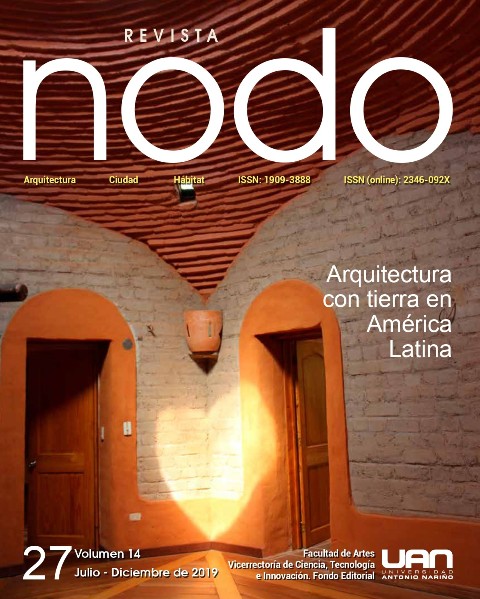Construcciones sostenibles, impactos ambientales
DOI :
https://doi.org/10.54104/nodo.v14n27.171Mots-clés :
envolvente en los edificios, eficiencia energética, materiales durables, Ciclo de vida de edificaciones (LCA), certificacionesRésumé
El Objetivo de Desarrollo Sostenible 11 procura garantizar que las ciudades y otros asentamientos humanos sean seguros, inclusivos, resilientes y sostenibles; la sostenibilidad deberá ser una característica intrínseca del urbanismo. En este trabajo se presentan algunos elementos relacionados con los tóxicos generados por los materiales de construcción, la envolvente en los edificios –eficiencia energética–, los materiales durables en la edificación, las tecnologías limpias, y las certificaciones; todo ello para decir que hoy, más que nunca, aprovechar la tecnología, el empleo correcto de los recursos, y un desarrollo sostenible e integral, con la responsabilidad ambiental, contiene la revisión del ejercicio profesional en el campo de la arquitectura, de la ingeniería, del urbanismo y de la construcción desde el proceso de diseño, con la selección de materiales, bajo la premisa de la sostenibilidad ambiental y no solamente por motivaciones estéticas y económicas. En este sentido los equipos de trabajo en dichos campos se verán obligados, en poco tiempo, a emplear sistemas de certificación y herramientas como el LCA al igual que la utilización de BIM con CAD y la escala en el manejo integral de los proyectos.
Téléchargements
Références
Acevedo, A. H.; Vásquez, H. A. & Ramírez, C. D. (2012) Sostenibilidad: actualidad y necesidad en el sector de la construcción en Colombia. Gestión y Ambiente, (15) 1, pp. 105-117.
Angelard, C.; Colard, A.; Niculita-Hirzel, H.; Croll, D. & Sanders, I. R. (2010). Segregation in a mycorrhizal fungus alters rice growth and symbiosis-specific gene transcription. Curr Biol. 20(13):1216-21. Doi: 10.1016/j.cub.2010.05.031
Adnan Enshassi, B. K. (2014). An evaluation of environmental impacts of construction-Evaluación de los impactos medioambientales de los proyectos de construcción . Revista Ingeniería de Construcción . Vol 29 Nº3, 1-21.
Alix Ruiz Ariza, A. J. (Julio-Diciembre 2017). Uso y demanda de Tecnologías Verdes en el sector de la construcción en Cartagena de Indias. Una aproximación teórica y práctica. SABER, CIENCIA Y Libertad ISSN: 1794-7154 Vol. 12, No. 2 , Págs. 83-91.
Bedoya, Carlos Mauricio (2003) El concreto reciclado con escombros como generador de hábitats urbanos sostenibles. Tesis de Maestría. Universidad Nacional de Colombia, sede Medellín.
Berglund, B., Lindvall, T., & Schwela, D. (1995). GUÍAS PARA EL RUIDO URBANO. En OMS, “Community Noise” (págs. 1-19). londres -Reino Unido: la Stockholm University y el Karolinska Institute.
BREEAM Building Research Establishment’s Environmental Assessment Method (2008) Offices Assessor Manual 2008. London: BRE Global Ltd.Centre for desing at royal Melbourne institute of technology. www.rmit.edu.au Enero 24 de 2011
CSIRO-Australia CommonwealthScientific and Industrial Research Organization (2010) Your home technical manual. htpp://www.yourhome.gov.au/ technical/index.html
DEUSKAR, C., & TEODORO FERREIRA, S. (28 de 06 de 2016). Banco Mundial. Obtenido de THE DATA BLOG: Una historia de muchas ciudades: el seguimiento de la urbanización en el mundo: ttps://blogs.worldbank.org/opendata/es/co
EPA-United States Environment Protection Agency (2008) Lifecycle construction resource guide. Atlanta:EPA.http://www.lifecyclebuilding.org/files/Lifecycle%20Construction%20Resource%20Guide.pdf
Franco, B. V. & Cardona, A. D. (2015). La responsabilidad social empresarial y la lucha contra la pobreza. Saber, ciencia y libertad, 10 (1), pp.115-124
Ordóñez Ortiz, A. (2012). ASENTAMIENTOS Y BARRIOS PRECARIOS. Laboratorio de proyectos urbanos. CITU. Experiencia Local (Colombia), 1-18.
Rocha-Tamayo, E. (2011). Construcciones sostenibles: materiales,certificaciones y LCA. Universidad Piloto de Colombia, Bogota, 1-26.
T. Maciel, M. S. (2016). Management system proposal for planning and controlling construction waste-Propuesta de un sistema de planificación y control de residuos en la construcción. Revista Ingeniería de Construcción Vol 31 Nº2, 1-12.
Villalba, A., Pattini, A., & Corica, M. (2012). Análisis de las características morfológicas de las envolventes edilicias y del entorno urbano desde la perspectiva de la iluminación natural. Laboratorio de Ambiente Humano y Vivienda. INCIHUSA. Consejo Nacional de Investigaciones Científicas y técnicas, 1-17.
Villanueba-solis, J., Ranfla, A., & Quintanilla-Montoya, A. (2012). Isla de Calor Urbana: Modelación Dinámica y Evaluación de medidas de Mitigación en Ciudades de Clima árido Extremo . Content Sever-Información Tecnologica vol 24., 15-24.
Téléchargements
Publiée
-
Résumé3163
-
PDF (Español)2084
Comment citer
Numéro
Rubrique
Licence

Ce travail est disponible sous licence Creative Commons Attribution - Pas d’Utilisation Commerciale - Partage dans les Mêmes Conditions 4.0 International.



 Portal de Ciencia Abierta
Portal de Ciencia Abierta